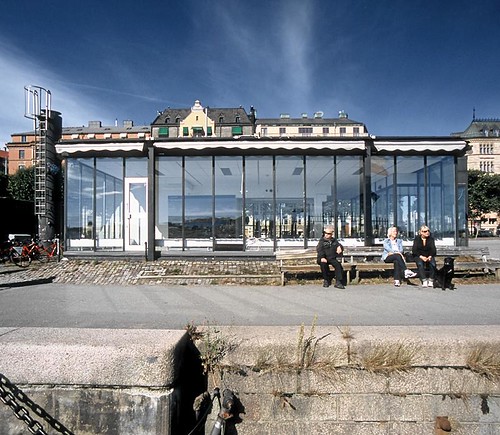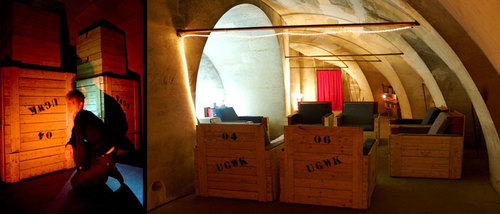Hello, what??
from Page Six via Gawker, we learn that Norman Mailer “built a 15,000- piece “City of the Future” with two pals in his Brooklyn apartment – but where it will go next, nobody knows.”
The obvious answer is “onto flickr.” The next most obvious answer is, “onto a Microserfs fan site.”
The Purpose Of Art Is To Make More Art
As the art market began heating up and becoming much more fashionable a few years ago, I started to wonder what the effect of all this demand would be on the art that was produced. Surely, 95-plus percent of the objects and paintings would not ever be made, projects wouldn’t be conceived, much less realized, in the absence of an insatiable-seeming market.
Sure, like Morris Louis and Clyfford Still before them, painters and drawers might produce work at a grueling pace, then roll them up and stuff them in a barn–or their parents’ suburban attic crawlspaces or whatever the equivalent is today. Conceptualists might follow Dan Flavin’s footsteps and design all their work and file it away for execution in the event anyone ever actually bought it. And that might be happening.
But there are giant works with cost- and labor-intensive production requirements; public commissions for new cultural capitals; hundreds of linear miles of art fair booth walls to be filled; follow-on rounds of loft and country home renovations proceeding apace. The art market needs product.
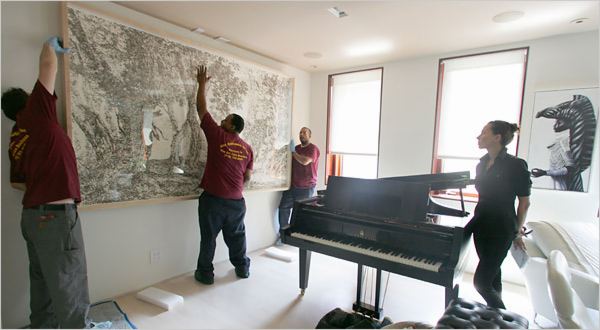
That photo a few weeks ago in the Times of yet another near-life-sized inky tree by Ugo Rondinone being art handled into place was a clincher; it accompanied an article about bankers and hedge fund managers compelled to quit their dayjobs in order to manage their serial seven- and eight-figure remodeling projects. Can someone please explain why I should care about art whose most salient feature is its ability to anchor a handrubbed plaster wall in a townhouse that never gets lived in?
I was pleasantly surprised to find that Richard Prince is a source of wisdom on this question of art world demand. Like the Dalai Lama, my problem isn’t with the man himself, but with his Richard Geres. And at this Conde Nast-LVMH-Guggenheim-Phillips dePury moment, the man has way too many Richard Geres.
Yet in the 4-part video follow-around on VBS.tv, Prince is very convincing when he says he doesn’t give a damn what anyone thinks about his work, and the good thing about people wanting to buy it is that it helps him make more work. Whether the world is a better place with a dozen more nurse paintings in it actually feels beside the point, even if it’s not. To see a nurse painting propped nonchalantly in the background, and to know that Prince could make another tomorrow–or not–imbues these now-precious objects with an unshakable arbitrariness, entirely subject to the artist’s prerogative. Which is entirely at odds with the disintermediating artifice of the primary dealer and her waitlists–and with the even more intense simulation of rarity of the auction block. And still we come.
It makes me think, too, of Olafur Eliasson’s work, but for entirely different reasons. As the scale, complexity and spectacle of Olafur’s work has expanded, most dramatically since his 2004 Turbine Hall installation, it’s sometimes seemed that literally any idea or iteration or object that crossed through his head could be realized. The question became, “should it?” With no apparent physical, production, or economic constraint, does the artistic process get inverted and lose the refinement, iteration, editing, and winnowing steps that presumably results in the strongest work?
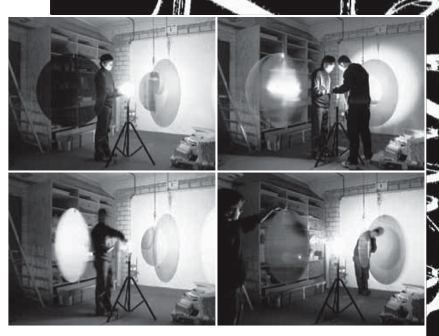
Is any/every possible configuration of hanging prism, spotlight, and rotating motor equally “good”? Do we weigh the significance of each element and decision differently if we know it’s the only one or if we know that every other variation exists somewhere, too, in a European private collection? Or is “uniqueness” as misplaced an object of our artistic rapture and devotion as “authorship”?
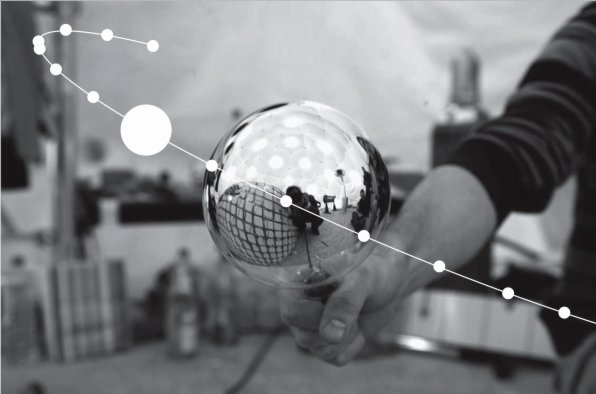
MIT art historian Caroline A. Jones pulled back the curtain on Olafur’s prodigious studio practice in an article for last month’s special Production issue of Artforum. Somehow threading the needle between the art world’s post-object conceptualism and the art market’s dazzling luxury consumerism, the studio has made experimentation and research its main “product”; which makes the saleable works something of a “by-product,” by-products which fund the ongoing idea production of the studio.
It feels like an imperative transposition for an artist to make, especially when cognizance of the demand for one’s work can create an existial crisis. I mean, I buy the stuff, and it often feels superficial, decorative, and money-flaunty; I can only imagine how it can feel to be making it.
And just as the mechanical means–lights, tripods, scrims, scaffolds, motors–used to create the natural phenomena have always been open, discoverable parts of each work, now Olafur’s studio is making its own process and mechanisms known.
Take Your Time is the Studio’s magazine. Vol. 1, Small spatial experiments, goes behind into the scenes, documenting several recent high-profile projects, including the Serpentine Pavilion, BMW’s Art Car, the Music Hall in Reykjavik, Pinault’s Venetian Christmas decorations, and some that could actually be considered small.
I don’t know if it’s coming to a Barnes & Noble near you, but I imagine it’ll be at the galleries. And it’s available as a nice, fat PDF file from the Studio website.
Take Your Time, Vol. 1, Small spatial experiments [olafureliasson.net]
Sata-Koons
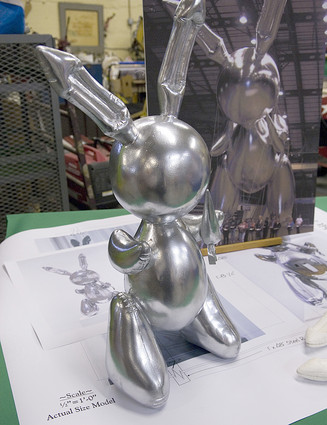
Alright, the clock is ticking, only hours to go until Jeff Koons’ largest work to date, a 53-foot high balloon based on his 1986 sculpture, Rabbit, bobs down the west side in Macy’s parade. It was made using a new material intended to replicate the original sculpture’s mirror-like stainless steel surface. Said Koons in a Macy’s press release, “I think one of the reasons why Rabbit is an iconic work, a popular piece, is because it’s so reflective. It reflects the needs of culture and society and can represent so many different things to the viewer.”
Courant’s critic wonders what I wondered, which is what other art balloons have been in Macy’s “Blue Sky Gallery” series? I can’t find any previous artists mentioned.
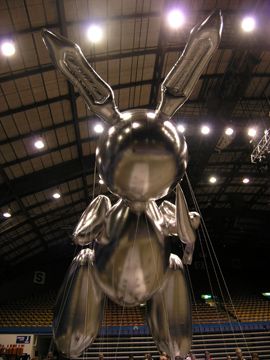
Anyway, Gallery or not, the Satelloon would not be able to appear in Macy’s parade; Manhattan’s avenues were laid out to be 100 feet wide, the same as the Satelloon itself. What with the streetlights and trees and whatnot, it just wouldn’t fit.
Still, I hope it’ll make a nice, intimate venue for Koons’s modestly scaled work.
Money quote: “A giant silvery rabbit that looks like a massive bunny-shaped UFO? [courant, also top image]
Rabbit inflation test shot via fashionweekdaily [fashionweekdaily.com]
Previously: The Satelloons of Project Echo
If I Were A Sculptor, But Then Again…
First, Shill For All The Writers
This is funny:
Not The Daily Show, With Some Writer
But this is funnier:
From the Colbert Report writers: hungvp158: “Very successful entertainment executive, who is also quite young for his position, on why scribes’ strike is asinine. Not tooting own horn or anything but he is very connected– squash, Iger– has inside dope. And ‘hung’ not an exaggeration.”
Round 1 goes to The Colbert Report writers. Back to you, John.
Architecture As Art History
I guess when you’re a hammer, everything looks like MoMA. It’s “Subverting The Dominant Installation” Week at Modern Art Notes, where Tyler is taking inordinate pleasure in shadow boxing with an opponent who retired long ago: Alfred Barr’s rickety, linear [sic] march of Modern Art history as experienced in the gallery walk at MoMA. As Tyler condemns it, Barr/Rubin/MoMA put Postwar New York at the center of Art, and annointed Jackson Pollock to lead everyone else to abstraction’s Promised Land. [But wait, maybe I can solve this problem before I even get started complaining. What if Clyfford Still is Moses, then Pollock could be Joshua!]
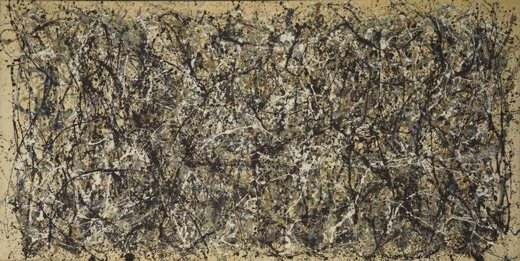
Tyler’s exercise interesting and–in this case–harmless, but it’s also artificial almost to the point of irrelevance. Set aside the discussion of just how much “dominance” MoMA’s installation has or should be granted in the polyvalent art world of 2007 [I’m a longtime MoMA supporter and fundraiser for whom the Museum functioned as an ersatz graduate school of modernism, which may be why I feel so strongly that the art world should have outgrown the self-inflicted notion of centralized canonizing authorities by now. And except for when we play these kinds of curatorial parlor games, I think most people have.]
The sequence of galleries on MoMA’s fifth floor forms the basis of MAN’s “dominant installation” theory:
MoMA’s installation, which is in part an accident of architecture and in part not (someone put all those Pollocks together and banished everyone else), encourages us to see Pollock as the titan, the artist who, along with Picasso and Matisse gets a MoMA gallery to himself. The not-so-subtle suggestion is that everything else in American hero painting stems from Pollock, that it all comes after him, that no one else is worthy of sharing his space. As proof, at MoMA those other artists all are after Pollock, not with him.
OK, but that’s not how it happened…
Tyler has been spending the last few days expanding on that by showing what other artists’ momentous works from 1950 which were created alongside [i.e., concurrent with] Pollock’s, but which MoMA baldly puts in other rooms.
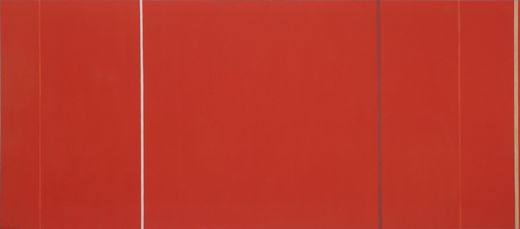
Rather than simply point out what seems to me an inherent flaw in Tyler’s premise–unless you’re talking about Jerry Saltz’s curatorial fantasy of lining up all the works in the collection by the date they left the studio, the march through architecture does not only ever equal the march of time; in fact, since its conception before the MoMA2000 era, the Taniguchi building & installation has been intended to alleviate, if not obviate, the outdated, pedantic, this-begets-that, historicist puzzle-solving–I’ll counter with a lost installation example from the, uh, Bad Old MoMA that I think unproves Tyler’s point today about Barnett Newman’s massive painting, Vir Heroicus Sublimis. It also happens to be one of the most sublime juxtapositions of art I’ve ever seen.
In the old MoMA’s 4th floor galleries, Pollock did have a gallery to himself, but it wasn’t the apotheosis of anything. The Pollock room was off to the right, with One: Number 31, 1950 on the main wall, while History marched on to the left; to the architectural determinists in the audience, Pollock was a dead end.
Only, of course, it wasn’t. When you turned around and looked through a couple of enfilade doorways, there was Newman’s Vir Heroicus Sublimis facing you–and the Pollock to your back. I forget what was in those galleries–late Matisse, maybe? who could care?–because these turning back and forth between these two giant paintings made the same year was too engrossing. Newman wasn’t taking the “next-steps of American high-abex,” he was making his own powerful arguments longside/against/in response to [sic] Pollock’s painterly actionism.
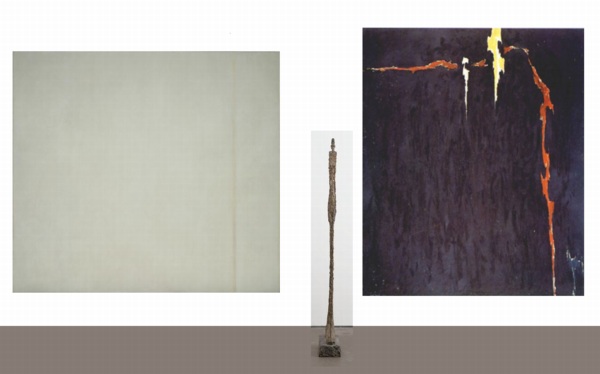
When you got into the room with the Newman, though, things really heated up. On the right/west wall [recreated above in Photoshop] hung another 1950 Newman, The Voice [above, l], and next to it was a Clyfford Still. If the timeline were the arbiter, it’d be 1951-T No. 3, a work whose reused abstract composition Still dubbed a “replica.” [Let’s see Pollock try that.] But I’m almost certain it was the much earlier–d’oh, and thus asynchronous–1944-N No. 2 [above, r].
The greatest touch, though, was the most seemingly controversial: the insertion of a European sculpture, Giacometti’s Standing Woman, from 1948, which functioned visually as, of all things, a humanoid zip. I’ve never looked in the literature, but I can’t imagine how this time- and continent-and style-hopping installation could be considered anything but heresy to those who insist that someone’s insisting on brightline, AbEx and The American Way art history. And yet, there it was, right there in the heart of MoMA. Did anyone complain? Or did it just look too awesome? Or was there always more to the Newman et al. story, like what artists themselves thought, even at MoMA? from Vir Heroicus Sublimus‘ page at MoMa.org:
Newman admired Alberto Giacometti’s bone-thin sculptures of the human figure, and his stripes, or “zips,” as he called them, may be seen as symbolizing figures against a void.
Taniguchi’s MoMA makes some attempt to break up the classical, enfilade march of galleries, but it’s obviously not perfect. The classical vista and the faceoff have been replaced by the turn and the oblique glimpse as the museum’s spatial and viewing modes. When they hung the new galleries, MoMA’s curators programmed in these pans and the distant glimpses of resonant works afforded by all the new, non-dogmatic doorways.
But even if you don’t buy into this attempt at mixing it up, can anyone realistically expect that MoMA would destroy itself as a historically continuous institution “merely” to accommodate the fifth renovation of its space? Should the ghost of a building known as the Dorset Hotel hold sway over Art History, its circumstances defining the shapes and flow of the galleries much as the one-by-one acquisition of the townhouses that once occupied the original 53rd Street site did? MoMA’s linearity, both spatial and intellectual, is a historical phenomenon as driven as much by these palimpsest floorplans as by Barr and Rubin’s schematic diagrams.
And this received wisdom is actually influenced as much by the trustees and collectors and tastes of the era, too; remember, despite several attempts by dealer/trustee Sidney Janis to place it there, Barr and MoMA refused Pollock’s Autumn Rhythm, which finally ended up at the Met. And it wasn’t until 1967, well into the Rubin era, that they could even manage to acquire One, No. 31, 1950 at all. If people actually knew more about the messy, cantankerous, and wrangling processes of how that “dominant installation” came to be, they may not be so inclined to let it dominate them.
And if they’re going to be strict architectural literalists in their interpretation of a the symbolism of a museum installation, they might as well look back to the Old Testament MoMA as well. And they might as well note that Newman’s painting currently hangs in the same spot as Picasso’s Les Demoiselles d’Avignon on the floor below. Maybe Newman is Moses and Pollock is just Aaron. Or Pollock’s John the Baptist, and Newman’s–well, I’m sure Newman would’ve been pleased with the spot he got.
Street And Gangland Rhythms 1959 Field Recording
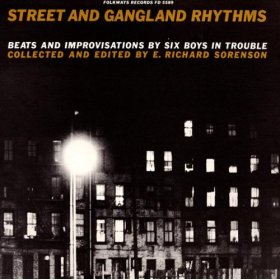
Ho-ly Mackerel, this is incredible.
Street and Gangland Rhythms: Beats and Improvisations by Six Boys in Trouble is a 1959 urban field recording LP from Folkways Records, a pioneer in folk music, field recording, and world music.
A rare record dealer has an original LP edition on eBay right now, “stone mint and in the shrink,” but Smithsonian Folkways also publishes most of the company’s archives either digitally or on CD.
Buy the mp3 download on Amazon for $8.99.
Check out a couple of extended samples at Show and Tell Music or at Smithsonian Global Sound [via storkbitesman]
Autoprogettazione: The Making Of An Enzo Mari Dining Room Table
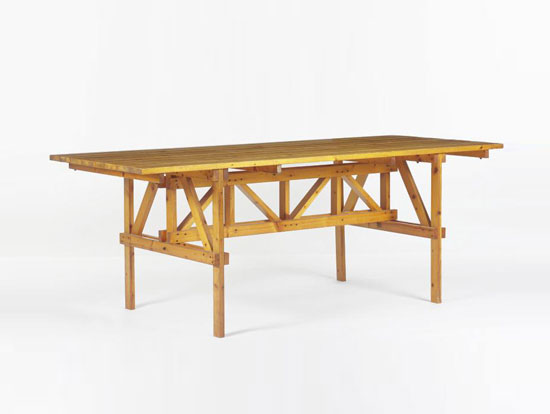
The economic and ecological and aesthetic far-sightedness of Enzo Mari’s 1974 Autoprogettazione still blows my mind. Translated variously as “self-projects,” and “self-design, self-made,” Mari’s collection of designs for furniture you could build yourself with just a hammer using cheap, off-the-shelf lumber anticipated several key design principles that resonate right now: DIY; sustainability; small-scale, local production and consumption; simplicity; handmade; hacking commercial products; and the open-source/creative commons movements [the furniture could be built by anyone except a factory or a dealer.]
Mari intended his Autoprogettazione to be made of #2 medium-grade, knotty pine, some of the humblest material on the market. He arranged for a company to pre-cut the lumber and sell it in packs as Metamobile. Naturally, one of these vintage 1974 kit tables sold for $14,400 at auction last fall.
Naturally, a gallery in Chelsea, Demisch Danant, just closed an exhibition of Metamobile furniture which they had made, and which they arranged for Mari himself to sign. Which seems to defeat several purposes of the entire Autoprogettazione concept, but that’s life.
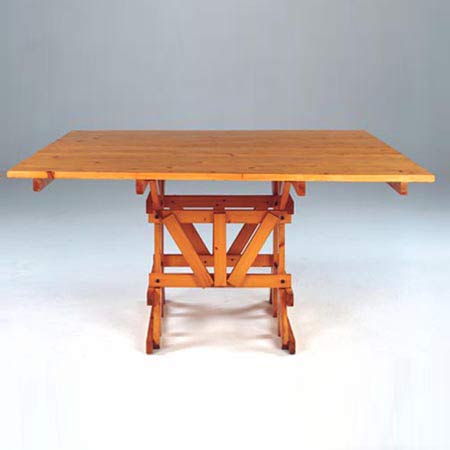
I’m looking for photos of the first Metamobile furniture I saw, which is still my favorite: In 2004, Rirkrit Tiravanija produced Mari’s square dining table [above] and some chairs in chrome-plated stainless steel. The pieces weighed a ton, but they were truly spectacular, like Koons picnic furniture.
Anyway, we’re just in the middle of moving our place in DC, which gives me the occasion to need a bigger, nicer dining room table. Mid-century modernism is too relentlessly tasteful; recent prices of “good” furniture make me laugh out loud. Though I’m an unrepentant Ikea fan, it only goes so far [i.e., no serious furniture]. Mari’s furniture feels like the perfect counterpoint to the homogeneous mega-catalogue stores: C&B, Pottery Barn, CB2, West Elm, etc. etc. etc.
So I’m thinking of getting the Truss Table [top] known as the EFFE Table. As a city dweller, I’d have to have it made, or at least have the lumber cut and finished and delivered for my own assembly.
An ex-pat design firm in Japan used sugi, Japanese cedar, to make their EFFE table. For me, I think it’s key to use Mari’s intended pine. So far, I’ve sourced two wildly disparate, but potentially interesting woods:
update: Those Demisch Danant pieces appear related to a series of 18 pieces put up at auction last June in Paris. Artcurial has a making of video, though they don’t actually show what they made. An EFFE Table went for EUR2,231.
Olafur’s Home Movies
Hello, Olafur Eliasson’s studio has a YouTube channel. A couple of months ago, right before the show opened at SFMOMA, he/they posted three videos that show various behind-the-scenes activities from your mobile expectations, the BMW Art Car project. Actually, part 1 has several shots of other works and studio activities, too. [Hi, Einar!]
They’re rather casually edited together, with no apparent arc and no narration, but they’re an interesting glimpse into Olafur’s studio process, which has expanded rather significantly in the years since I last visited. The videos are a nice complement to the Artforum article on the same topic, minus the elaborate contextualizing discourse, of course.
1/3 Studies for your mobile expectations – bmw h2r project
2/3 Studies for your mobile expectations – bmw h2r project
3/3 Studies for your mobile expectations – bmw h2r project
http://youtube.com/user/olafureliasson [youtube]
Cabinet’s Got Huge Balls
The Joshua Foer photo timeline, “A Minor History of Giant Spheres,” that got me all hopped up on Satelloons, is now online. It’s in the latest issue of Cabinet Magazine.
And while you should always buy or subscribe to Cabinet, the photos online are, on average, much bigger. The curse of the printed timeline format, I guess. [via kottke]
Previously: I will someday install a Satelloon in Grand Central Station, the Pantheon, and/or the Piazza San Marco.
“the most beautiful object ever to be put into space”
Dude, Under Siege, Blackwater Takes On Air Of Dwell Magazine!

Modular, prefab, minimalist, outdoor space, nice matte finish, shipping containers… Just slap a couple of solar panels on the roof and get a book stylist in there to add a Moholy-Nagy monograph to the coffee table, I think we have our January cover!
Under Siege, Blackwater Takes On Air of Bunker [nyt]
So Apparently, We’re Moving To Strandvagen, Sweden
where we’ll live in this unused 1954 Shell station by Peter Celsing. It’s so funny, I always imagined Sweden was cold and dark, but just look at this picture, taken at 3AM. Now we know that Ikea gets its blue from the color of the always-sunny Swedish sky.
[via andy]
Here are photos of the Shell station when it was still in use. [zlattes.com]
Previously: I want to live in a gas station
JMW Turner Overdrive
Time has a great review of the big JMW Turner exhibition–at the Museum of Modern Art in 1966.
The Washington Post, meanwhile, has an incomprehensible ramble about the bigger Turner exhibition at the National Gallery. Does Turner’s 40+ year-old position as an ur-Impressionist, ur-modernist still hold up? Who knows?
Landscapist in Light [time.com]
Turner, In Full Light [washingtonpost.com]
Come To The Drawing Center Curator Slam, Fri. Oct. 26
The Drawing Center has invited me to participate in a “Curator Slam” this Friday to celebrate the launch of their new Online Viewing Program. One of the Center’s greatest strengths has been its slide registry, which enabled artists who hadn’t shown in New York before to get their work in front of collectors, curators, dealers, critics, and the public.
Now the Viewing Program is available online, and offers a variety of search techniques–by medium, artist location, keyword, date, and artists’ text–to dig into the registry.
The Curator Slam will be–I’m told–a live, real-time curating/surfing event, where several of us simultaneously search the registry in front of the crowd, in order to put together a virtual exhibit of works on a given theme [to be provided that night, possibly via a fancy envelope or a fishbowl full of paper scraps.]
So far, I’ve played around with the Registry a bit, trying to see what kinds of results various searches produce. I can already feel that the “exhibit” produced will be as much about the process and the search tool as about the work or the artists. Reviewing work from gridded thumbnails inevitably impacts how and what you see; intimate subtleties are lost, while bold or easily read gestures and compositions are, well, easily read. Likewise, the artist’s statement and her very words, in fact, take on a more prominent role than they ever would in a gallery. It’s literally a filter by which the registry audience reaches the work. [On the other hand, I can’t imagine a single reason why the artist’s hometown would be relevant for searching/discovering his work. Though there are plenty of non-art reasons I can think of…]
The slam is free, and if you’re in town and easily amused, I would love to have a sympathetic face or two in the crowd–or at least an articulate heckler. It starts at 6:30, which gives you plenty of time to get in and out of Lucky Strike afterwards, and on with the rest of your evening.
Viewing Program Curator Slam, Friday, October 26, 6:30 PM, The Drawing Center, 35 Wooster St [drawingcenter.org]
The Drawing Center Viewing Program
Related: The Drawing Center’s 4th annual benefit auction is Nov. 7th. Check out the donated works.
It’s A Small Warhol’s World
I’m still looking around for anyone who gave an account of yesterday’s discussion of Warhol films at the American Museum of the Moving Image. Warhol Film Project director Callie Angell and film critic Amy Taubin were supposed to “discuss the artistic significance of Warhol’s films, the social and cultural milieu surrounding their production, and the history of their reception and their restoration.”
If you see something, please say something.

still from Inner and Outer Space, 1965
And as for the AMMI’s ongoing Warhol’s World film screening series, you should definitely see something. There are several reels of Screen Tests being shown. On Nov. 3rd, Saturday afternoon, a new print of Outer and Inner Space, the innovative double image, video-on-film portrait of Edie Sedgwick is screening. After that is a new print of Chelsea Girls. And the next week, Nov. 11th, is a new print of Lonesome Cowboys, which stars–among other people–Allen Midgette, the actor who pretended to be Andy during a 1967 speaking tour of western university campuses.
Warhol’s World – Screenings & Events, through Nov. 11th [movingimage.us]
Previously:
Have you seen me? Warhol’s lost videos
The Fake Warhol Lectures
Crate & Burial: UnterGunther’s Pantheon Workshop
It looks like the RISD Mall Dwellers have some stiff, French competition. Via UX frontman and UnterGunther spokesman Lazar Kunstmann comes this most excellent photo of the crates the guerilla restorers used to camouflage their workshop in the Pantheon, the mausoleum of the stars in Paris.
I would totally buy one of these–or two, really, since you’d want a matching pair–if they were exhibited and made available, say, as an art edition. And how cool would it be to have a little mantle-sized replica of the 19th-century clock movement the group repaired while hiding behind those crates for a year? Though I really do like the idea of urban exploring for fun and country, not fun and profit. Still, a guy can dream. [thanks, Lazar!]
Previously: the full UnterGunther Pantheon story, plus more urban exploration

